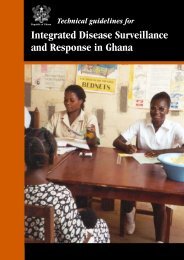Annual Programme of Work 2005 - Ministry of Health
Annual Programme of Work 2005 - Ministry of Health
Annual Programme of Work 2005 - Ministry of Health
You also want an ePaper? Increase the reach of your titles
YUMPU automatically turns print PDFs into web optimized ePapers that Google loves.
• Number <strong>of</strong> villages reporting guinea worm disease (905 at October, projected to 950 at<br />
December 2004) reduced by at least 25% to 700 or less.<br />
• Number <strong>of</strong> guinea worm cases reduced to 3500.<br />
Neglected Diseases affecting the Poor almost exclusively<br />
Six main diseases – Buruli ulcer, Trachoma, Leishmaniasis, Schistosomiasis,<br />
Onchocerciasis, Yaws, and Filiariasis - almost exclusively affect the poor. Apart from<br />
Buruli Ulcer and Onchocerciasis, which are fairly widespread, all the other diseases are<br />
focal. Trachoma is located predominantly in the northern and upper West regions.<br />
Leishmaniasis is an emerging disease, which is spreading especially in the Volta region.<br />
Filariasis is predominant in the Northern and Western regions. The general issues<br />
common to all these diseases are that they are under funded, have difficulties with<br />
treatment, and require community participation in their management. The focus for <strong>2005</strong><br />
is to raise the pr<strong>of</strong>ile <strong>of</strong> these diseases and ensure they are adequately funded within the<br />
district budget.<br />
Priority activities would include:<br />
• Establish the burden <strong>of</strong> diseases and distribution <strong>of</strong> these diseases<br />
• Develop a strategic framework for the prevention and control <strong>of</strong> each <strong>of</strong> the five<br />
neglected diseases<br />
• Provide guidelines and protocols for control <strong>of</strong> all neglected diseases<br />
• Earmark and allocate poverty reduction funds at central level and funds within the<br />
district budget to support the prevention and treatment <strong>of</strong> these diseases.<br />
• Incorporate the surveillance <strong>of</strong> these diseases into the integrated surveillance system<br />
• Supporting relevant operational research into the management <strong>of</strong> these diseases.<br />
Expected Outputs/Results<br />
• <strong>Programme</strong> for control <strong>of</strong> each <strong>of</strong> the five neglected diseases in place<br />
• Baseline on the diseases established<br />
• Strategic framework in place<br />
• Proportion <strong>of</strong> budget allocated to these diseases<br />
• Coverage <strong>of</strong> interventions increased<br />
Prevention and Control <strong>of</strong> Non Communicable Diseases<br />
The burden <strong>of</strong> non-communicable diseases (NCD) in the country is largely unknown.<br />
However, NCD are increasingly responsible for outpatient attendance and admission. In<br />
2003, hypertension was the 5th leading cause <strong>of</strong> outpatient morbidity in all ages, but<br />
second leading cause in both male and female adults older than 45 years. At KBTH,<br />
between 1990 and 1997, chronic diseases and complications accounted for more than<br />
two-thirds <strong>of</strong> all medical admissions and more than 50% <strong>of</strong> all deaths.<br />
15















